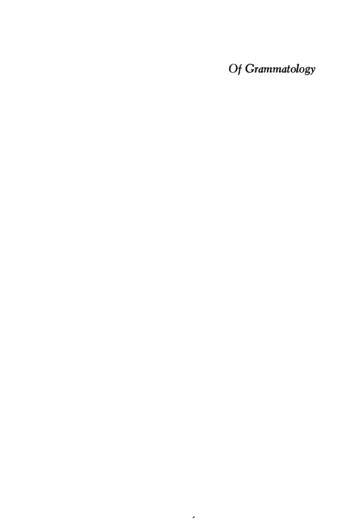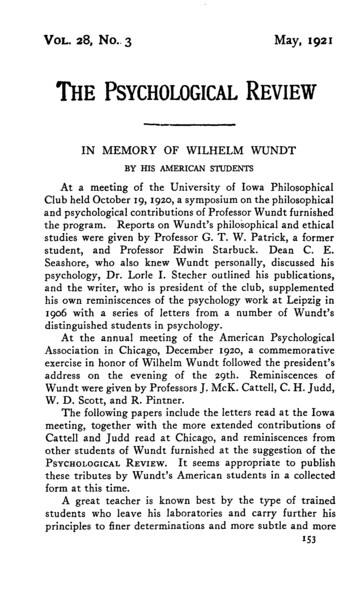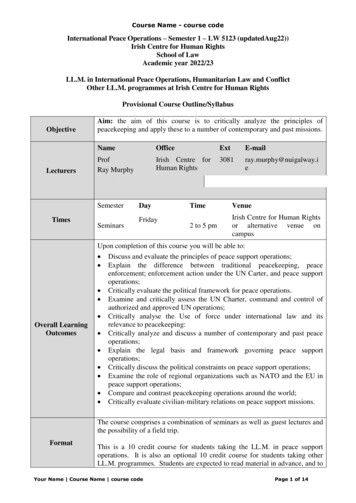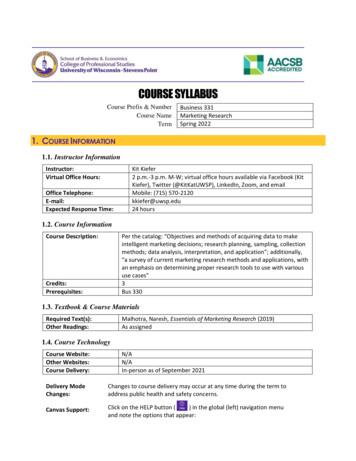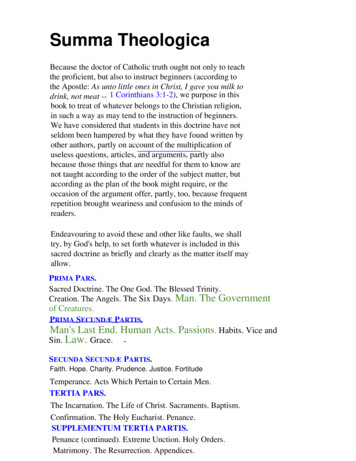
Transcription
Course Name: Philosophical Underpinnings of ABACourse ID: PSY 534Semester: Fall 2019Mode: Face-to-faceInstructor: Melanie DuBard, Ph.D., BCBA-DEmail: mdubard@umasd.eduPhone: 508 999-8349Office: Liberal Arts Building 396KCourse DescriptionThis course will focus on the scientific and philosophical underpinnings of behavioranalysis. It will trace the historical development of radical behaviorism to currentapplied behavior analysis, and professional practice guided by the science ofbehavior analysis.Student Competencies. (As linked to the BACB Fifth Edition Task List) Studentswho successfully complete the course will develop knowledge and skills related tothe following competencies:A. Philosophical UnderpinningsA-1 Identify the goals of behavior analysis as a science (i.e., description, prediction,control).A-2 Explain the philosophical assumptions underlying the science of behavioranalysis (e.g., selectionism, determinism, empiricism, parsimony, pragmatism).A-3 Describe and explain behavior from the perspective of radical behaviorism.A-4 Distinguish among behaviorism, the experimental analysis of behavior, appliedbehavior analysis, andprofessional practice guided by the science of behavior analysis.A-5 Describe and define the dimensions of applied behavior analysis (Baer, Wolf, &Risley, 1968).Prerequisite: This is the first course in the ABA program sequenceCourse Credits: This is a three-credit courseRequired Readings:Cooper, J., Heron, T., & Heward, W. (2007). Applied Behavior Analysis, 2nd ed,Pearson.Kasdin, A. E. (1982). Single-Case research designs: Methods for clinical andapplied settings. Oxford University Press, New York.
Dixon, D. R., Vogel, T., & Tarbox, J. (2012). A brief history of functional analysisand applied behavior analysis. In Matson, J.L. (ED.) Functional assessment forChallenging BehaviorsSkinner, B. F. (1974). About behaviorism. Random House, New York.Skinner, B. F. (1966). What is the experimental analysis of behavior? Journal ofthe Experimental Analysis of Behavior, 9, 213-218.Baer, D. M, Wolf, M. M., & Risley, T. R. (1968). Some current dimensions ofapplied behavior analysis. Journal of Applied Behavior Analysis, 1, 91-97.Slocum, T. A., Detrich, R., Wilczynski, S.M., Spencer, T.D., Lewis, T. & Wolfe, K.(2014). The evidence-based practice of applied behavior analysis. Behavior Analyst,37, 41-56.Philips, E. L. (1968). Token reinforment procedures in a home-stylerehabilitation setting for “pre-delinquent” boys. Journal of Applied Behavior Analysis,1, 213-223.Bailey, J., & Meyerson, L. (1969). Vibration as a reinforcer with a profoundlyretarded child. Journal of Applied Behavior Analysis, 2, 135-139.Lovaas, I. O., & Simmons, J. Q. Manipulation of self-destruction in three retardedchildren. Journal of Applied Behavior Analysis, 2, 143-157.Panyan, M., Boozer, H., & Morris, N. (1970). Feedback to attendants as areinforcer for applying operant techniques. Journal of Applied Behavior Analysis, 3,1-4.Azrin, N. H, & Foxx, R.M (1971). A rapid method of toilet training theinstitutionalized retarded. Journal of Applied Behavior Analysis, 4, 89-99.White, G. D., Nielsen, G., & Johnson, S.M. (1972). Timeout duration and thesuppression of deviant behavior in children. Journal of Applied Behavior Analysis, 5,111-120.Horner, D. R, & Keilitz, I. (1975). Training mentally retarded adolescents tobrush their teeth. Journal of Applied Behavior Analysis, 8, 301-309.Page, T.J., Iwata, B.A, & Neef, N. (1976). Teaching pedestrian skills to retardedpersons: Generalization from the classroom to the natural environment. Journal ofApplied Behavior Analysis, 9, 433-444Carr, E. G., Newsom, C. D., & Blinkoff, J. A. (1976). Stimulus control of selfdestructive behavior in a psychotic child. Journal of Abnormal Child Psychology, 4,139-153.
Lovaas, O. I., Freitag, G., Gold, V. J., & Kassorla, I. C. (1965). Experimentalstudies in childhood schizophrenia: Analysis of self-destructive behavior. Journal ofExperimental Child Psychology, 2, 67-84.Knight, M.F, & McKenzie, H.S. (1974). Elimination of bedtime thumb suckingin home settings through contingent reading. Journal of Applied BehaviorAnalysis,7,33-38.Chapman, C., & Risley T.R. (1974). Anti-litter procedures in an urban highdensity area. Journal of Applied Behavior Analysis,7, 377-383.Skinner, B.F. 1989. Recent issues in the analysis of behavior. MerrillPublishing Company, Columbus, Ohio.Course Requirements:Readings: For each class there will be chapters and/or research articles assigned toread.Presentation of Readings: Students will be assigned in advance to present an article.Presentation of articles should focus on (a) the rationale for the study, (b) briefdescription of the method and results (c) evaluation of if the study was consistentwith the goals of behavior analysis as a science (d) and a discussion of how thestudy addressed the dimensions of ABA. Each presentation and discussion shouldbe a total of 20-30 minutes.Quizzes: At the beginning of some classes, there will be a short quiz based on theprevious classes readings. There could be a quiz before any class, so it is importantto read all articles/chapters carefully.Classroom Participation: Participation includes participation in the discussion of thematerial.Final Exam: There will be a final examCourse ObjectivesCourse Objectives: By the end of the semester students will: Identify the goals of behavior analysis as a science Describe the philosophical assumptions underlying the science of behavioranalysis
Demonstrate knowledge of radical behaviorism and how it is related toapplied behavior analysisDistinguish among behaviorism, the experimental analysis of behavior,applied behavior analysis, and professional practice guided by the science ofbehavior analysisDescribe the dimensions of applied behavior analysisMethods of EvaluationeeemmmbvbbnnMethods of EvaluationMethods of EvaluationEvaluation and Grading Breakdown: Class participation/attendance Quizzes Student presentations Final exam15%25%25%35%Substantive participation should: Add value to the discussion and avoid simply repeating, agreeing with, oranswering yes or no to peer’s comments Challenge comments in class, including those of the facilitator Ask insightful questions Answer other people’s questions Exemplify the point with real-life events, when possible Make comments that are relevant to the course content and objectivesIdeas for substantive participation include: Share an experience that is related to the discussion. Comment on otherparticipants’ experiences that are related to the course. Ask others questions about their ideas and experiences that are related to thecourse Challenge a point that another participant made in a respectful manner. Offera different perspective on an idea that is being discussed Give insights gained from readings that were assigned for the week. If youneed more information, ask the participants a question about the week'sreading Discuss a work issue that is related to the course or discussion and ask forfeedback Relate how you have applied what you have read, learned or discussedregarding the course to your personal and professional life Share another resource such as Web links, books, etc. that you have used toanswer other participants’ questions or as you explore the topics of thecourse (as it is a violation of copyright law to copy the actual page)Final course will convert to the following letter grades:
Final Course Average93 and above90-9287-8984-8680-8377-7966-7665 and belowGradeAAB BBC CFLate AssignmentsAll assignments are expected to be completed by the assigned due date. If you willnot be able to get an assignment completed by the due date, contact me by email.All students are expected to participate in classes. Missing a class will result in zeroparticipation points for that classUniversity PoliciesThe link below provides information on:- Workload and Class Planning Policies- Academic Policies- Accommodations and Support h/provost/omnibus language forsyllabi -jan 11 2019.pdfScheduleWeek/Date BeginningWeek 1Unit of Instruction TopicFormat of class: InstructorpresentationTopics: WelcomeCourse NoneActivity:LectureHistory of ABA videosThe importance of description,Evaluation:prediction, and control in behavior Participation in class discussionanalysis
Week 2Week 3Format of class: InstructorpresentationTopics: Philosophicalassumptions underlying thescience of behavior imentation-replication-parsimony-philosophic doubt-pragmatismFormat of class: InstructorpresentationTopic: Early Psychologyinfluences on behavior analysis-Introspectionism-Pavlov-WatsonWeeks 4 and 5Format of class: InstructorpresentationTopic: Role of Skinner in ABA- From Watson’s S-R to S-R-S- introduction of the distinctionbetween operant and respondentbehavior- introduction of functionalrelationships- the Experimental Analysis ofbehavior- -Establishment of basics ofbehavior analysis- rate, singleorganism, visual analysis, etc.-Skinner box-Intermittent reinforcementReading:Cooper et al. 2007, chapter 1Activity:LectureClass discussionBehavior analysis VideosEvaluation:Participation in class discussionPossible quizReadings:Kasdin, 1982, Chapter 2Activity:LectureClass discussionIntrospectionism VideoEvaluation:Participation in class discussionPossible quizReadings:Dixon, Vogel, & Tarbox 2012Skinner, (1974) About Behaviorism, Chapter 4Activity:LectureProject Pigeon videoSkinner videoClass discussionEvaluation:Participation in class discussionPossible quiz
Week 6-Project PigeonFormat of class: InstructorpresentationTopic: In Skinner’s words- mentalism- structuralism- radical behaviorism- methodical behaviorismWeek 7Format of class: InstructorpresentationTopic:- Innate behavior- Operant behaviorWeek 8Format of class: InstructorpresentationTopic: Applied Behavior analysis- how different from experimentalbehavior analysis, behaviorism,and professional practice guidedby the science of behavior analysisWeek 9Format of class: InstructorpresentationTopic: Dimensions of ABAReadings:Skinner 1974 Chapters 1 and 2Activity:LectureClass discussionSkinner videosEvaluation:Class discussionPossible quizReadings:Skinner 1974 Chapters 3 and 4Activity:Narrated PowerpointSkinner video’sEvaluation:Online assignmentReadings:Slocum et al. 2014Activity:LectureClass discussionEvaluation:Class discussionPossible quizBaer et al. 1968Activity:LectureClass discussionEvaluation:Class discussion
Week 10Format of class: InstructorpresentationsTopic: More Skinner readings- Summing up- The behavior of organismsat 50Weeks 11, 12, and 13Format of class: StudentpresentationsTopic: Early examples of practicebased on radical behaviorism andapplied behavior analysisPossible quizReadings:Skinner (1974) Chap 14Skinner (1989) Chap 12Activity:LectureClass discussionEvaluation:Class discussionPossible quizReadings:Phillips 1968Bailey & Meyerson, 1969Lovaas & Simmons, 1969Panyan et al. 1970Azrin & Fox, 1971White et al. 1972Horner & Keilitz, 1975Page et al. 1976Carr et al. 1976Lovaas et al. 1965Knight & McKenzie (1974)Chapman & Risley (1974)Activity:Student presentationsClass discussionEvaluation:
Week 14Final ExamClass discussionPossible quiz
Course Name: Philosophical Underpinnings of ABA . Course ID: PSY 534 . Semester: Fall 2019 . Mode: Face-to-face . Instructor: Melanie DuBard, Ph.D., BCBA-D Email: mdubard@umasd.edu Phone: 508 999-8349 Office: Liberal Arts Building 396K . This is the first course in the ABA program sequence . Course Credits: This is a three-credit course .

